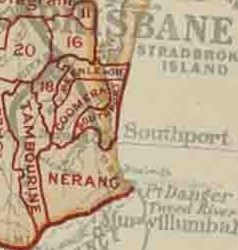Town of Southport facts for kids
The Town of Southport was a special area in South East Queensland, Australia, that had its own local government. Think of it like a town that managed its own local rules and services, similar to how your city or town council works today.
Contents
The Story of Southport's Local Government
On 11 November 1879, two areas called the Nerang and Coomera Divisions were created. These were among the first 74 local government areas in Queensland.
Then, on 6 July 1883, the Southport Division was formed. It was made from parts of both the Nerang and Coomera Divisions.
Later, on 6 February 1889, a small part of Southport Division became a separate area called the Shire of Southport. But this didn't last long! On 30 June 1892, this separate shire was ended, and the original Southport Division was put back together.
When a new law called the Local Authorities Act 1902 was passed, the entire Southport Division officially became the Shire of Southport on 31 March 1903.
On 12 April 1918, the Shire of Southport changed its name and became the Town of Southport.
A new town hall, where the local government worked, was opened in 1935. This building is now a protected heritage site.
Big Changes: Councils Joining Up in 1948
On 9 December 1948, there was a big change for local governments in South East Queensland. Many smaller areas were combined into larger ones. This process is called an "amalgamation."
Ten local government areas between City of Brisbane and the New South Wales border were replaced by just four new ones. The ten old areas were:
- Beaudesert
- Beenleigh
- Cleveland
- Coolangatta
- Coomera
- Nerang
- Southport
- Tamborine
- Tingalpa
- Waterford
The four new, larger local government areas created were:
- The Town of South Coast: This was a combination of the Towns of Southport and Coolangatta, plus the Burleigh Heads part of Nerang. This area later became the famous City of Gold Coast.
- The new Shire of Albert: This joined Beenleigh, Coomera, most of Nerang, the southern part of Tingalpa, and the eastern part of Waterford.
- An enlarged Shire of Beaudesert: This combined Beaudesert and Tamborine with the western part of Waterford.
- The new Redland Shire: This joined Cleveland and the northern part of Tingalpa. This area later became Redland City.
These changes officially started on 10 June 1949, when the first elections for the new councils were held.
Who Led Southport? Chairmen and Mayors
The leaders of Southport's local government were called "Chairmen" when it was a Division or Shire, and "Mayors" when it became a Town. They were like the head of the local council, making important decisions for the community.
Chairmen of the Division of Southport
| Chairman | Term |
|---|---|
| Robert F. Johnston | 1883, 1900–1902 |
| William Charles Welsh | 1884–1889 |
| C. A. Beetham | 1890–1891 |
| George Andrews | 1892 |
| Thomas M. Kirk | 1893–1896 |
| W. Downs | 1897 |
| Edward Hicks | 1898 |
| Edward Proud | 1899 |
Chairmen of the Shire of Southport
| Chairman | Term |
|---|---|
| Theodor Lenneberg | 1889 |
| William Lather | 1890–1891 |
| Edward Hicks | 1903, 1905, 1911 |
| Edward Fass | 1904, 1917 |
| C. A. Beetham | 1904* |
| Ernest Freeman | 1906, 1913–1916 |
| J. W. Proud | 1907 |
| H. Soegaard | 1908 |
| George Andrews | 1909, 1912 |
| John Siganto | 1910 |
Mayors of the Town of Southport
When Southport became a Town, Edward Hicks was chosen as its first mayor on 11 May 1918. After that, mayors were chosen by the people in elections held every three years.
| Mayor | Term | Notes |
|---|---|---|
| Edward Hicks | 1918–1921 | |
| Edward Fass | 1921–1924 | |
| Washington Waters | 1924–1927 | |
| Joseph Hendry Grice | 1927–1930 | |
| C. H. Steadman | 1930–1933 | |
| Henry Wilson | 1933–1936 | |
| Joseph Wood Proud | 1936–1948 |


